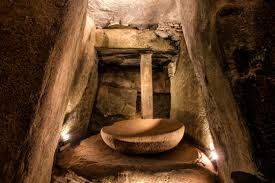We took some time off recording to experience something that many of you just wont be interested in - Newgrange and Checking out Galway.
It was another down time we allowed ourselves.
Newgrange has been on my bucket list for years and the last time we were in Ireland we rocked up only to find out that bookings were necessary it it was not going to happen.
This time the tickets had been booked for us and we could hardly contain ourselves.
Newgrange is a 5,200 year old passage tomb. It is one tomb were you can go inside to see what it looks like although you are packed in with at least 30 other people and once inside you cannot move around.
All cameras and recording equipment are left outside and the tour guide tells you why it is so special.
It IS VERY SPECIAL.
Museum.ieWe were allowed about 15 to 20 minutes inside and then had to leave to make way for the next group to enter.
I think this would have been the process all day long.
To consider the craftsmanship required to shift stones and place them in such an extraordinary way was mind blowing to see.
discoverboynevalley.ie
This ash dish was just as incredible. This thing was bigger that the entrance cavity, so the builders would have had to craft this within the space it sits in.
Then it was on to Galway and our hotel for the next three nights as we explore this seaside city.
Galway is pretty and we had not visited this part of Ireland before.
We visited the Mother and Baby Memorial in Tuam which is about 45mminutes from Galway.
This is a spot which serves as a reminder about the dark history of single mothers and their terrible treatment at the hands of the Catholic nuns at 'maternity hospitals'.
Not all babies were welcomed events and not all could be cared for by their mothers and there was period of time in Ireland where unwed mothers were taken in to be looked after and children were given up to be cared for by other families who could manage another mouth to feed.
In the case of the site in Tuam one care facility did not pass on the children to other homes but took it upon themselves to pass judgement whether the child lived or died. Almost 800 tiny bodies were disposed of in a sewerage tank in Tuam in great secrecy up to the 1960's.
This was later found in the 1990's.
Now there is a small monument on the spot where the bodies were found and it made all of us terribly sad to think that the Catholic Church was at the forefront of this.
Disgusting.
nytimes.com
Reading more about the life of the women and the little ones it brings tears to my eyes.
Women were treated as sinners and even in the worst possible labour women would not be given painkillers as they deserved the pain they were suffering as it was God's punishment upon them.
WTF?!!!!
But...I need to breathe because I can feel the anger rising every time I think about it.
We tried to get the images out of our heads and went into Galway in the evening to have a drink to the little ones and wish them peace. Galway is a lovely place and we chose the Skeffington Arms Inn to drown our sorrows.
Tomorrow is another day.



Comments
Post a Comment